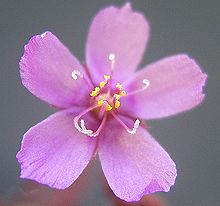Drosera hartmeyerorum
| Drosera hartmeyerorum | ||||||||||||
|---|---|---|---|---|---|---|---|---|---|---|---|---|

Drosera hartmeyerorum at the type location |
||||||||||||
| Systematics | ||||||||||||
|
||||||||||||
| Scientific name | ||||||||||||
| Drosera hartmeyerorum | ||||||||||||
| Smarter |
Drosera hartmeyerorum is a carnivorous plant of the genus Sundew ( Drosera ) in the Arachnopus section . It was discovered in 1995 by Siegfried and Irmgard Hartmeyer in Australia (after whom it is named) andfirst describedby Jan Schlauer in 2001. It is particularly noteworthy because of the non-glandular, reflective emergence typical of it, which similarly could onlybe detectedfor Drosera indica so far.
description
Drosera hartmeyerorum is an unbranched, annual plant with few, fibrous roots that are slightly thickened at the end. It reaches a height of up to 30 centimeters. Younger plants stand upright, older ones grow lying down, whereby the active end of the stem axis always remains upright. The plant is colored deep red.
leaves
Stand on the thin, studded with glandular hairs Sprossachse the linealischen, 3 to 5 centimeters long and 1.5 mm wide sheets of up to 3 millimeters long leaf stalks, stipules absent. Young leaves stand upright, with increasing age they tilt, old leaves hang down withered.
At the outermost point the leaf blades are pointed, on the surface they are covered with tentacles that are around 1 millimeter long on the blade, up to 2 millimeters at the edge and over 5 millimeters long at the tip of the leaf.
Non-glandular emergences
In addition to the glandular hairs, non-glandular emergence could also be observed in Drosera hartmeyerorum . These bright yellow and clearly visible emergences are concentrated at the base of the leaves and above the crescent-shaped bracts of the inflorescence. They are 3–4 millimeters tall, stalked and have a mulberry-shaped head.
A lens-like structure made of honeycomb-shaped, transparent giant cells sits on a transparent tentacle stem, which focuses incident light on a compact, bright yellow center. The bright yellow color does not come from the surface of the specialized tentacle head, but is reflected from the inside. Since the color perception of insects is shifted into the short-wave range, the dark red bracts and catch leaves are a high-contrast, almost black background for them, against which the light yellow emergences glow intensely when exposed to light.
Snap action
However, another specialization awaits insects attracted by the emergence, because the lower 8–10 cm of the flower stem is completely smooth and free of glands and bracts. So when an insect reaches the first bract with emergence (seen from the plant center), it has the very smooth stretch in front of it, at the end of which the bundles of emergence shine out of the dark red plant center, densely covered with glue tentacles. Flying or jumping there effectively traps smaller insects.
When observing the site, most of the prey consisted of young grasshoppers, which are very common in the region at the end of the rainy season. It is assumed that the interaction of the emergences and the flower stalk standing vertically above the plant has resulted in an increased effectiveness of catching prey compared to the glue traps of rainbow plants and other sundew species that compete at the site .
Distribution and habitat
The species is only known from its type location on the Ord River near Kununurra in Australia .
literature
- Jan Schlauer: Drosera hartmeyerorum spec. nov. (Droseraceae), a New Sundew in sect. Arachnopus from Northern Australia. In: Carnivorous Plant Newsletter. Vol. 30, No. 4, 2001, ISSN 0190-9215 , pp. 104-106, ( online version ).

